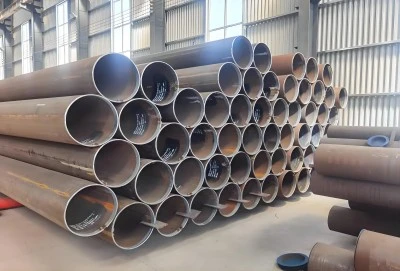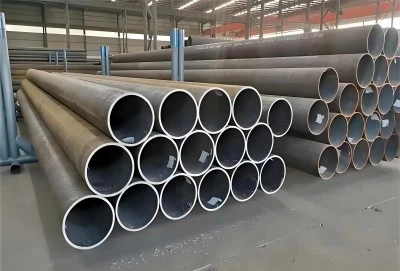When it comes to ensuring the quality and reliability of pipelines in the oil and gas industry, proper inspection of carbon steel API 5L X65 PSL1 pipes is crucial. These carbon steel pipes are widely used for their excellent strength and durability, making them ideal for transporting oil and gas over long distances. In this comprehensive guide, we'll explore the essential inspection methods for API 5L X65 PSL1 pipes, focusing on three key tests: the Flattening Test, Visual Inspection, and Hydrostatic Test.
|
|
|
Flattening Test
The Flattening Test is a critical procedure in evaluating the ductility and weld integrity of carbon steel API 5L X65 PSL1 pipes. This test involves compressing a section of the pipe between two flat plates until the opposite walls meet. The purpose is to assess the pipe's ability to withstand deformation without cracking or breaking, particularly at the weld seam.
To perform the Flattening Test:
- Cut a ring sample from the pipe, typically 4 inches (101.6 mm) long.
- Place the sample between two flat, parallel plates.
- Apply pressure gradually until the specified distance between the plates is reached.
- Inspect the sample for cracks or other defects, paying special attention to the weld area.
The acceptance criteria for the Flattening Test depend on the pipe's outside diameter (OD) and wall thickness. For API 5L X65 PSL1 pipes, no cracks or breaks should be visible in the test specimen, especially along the weld line. This test is particularly important for welded pipes, as it helps identify any weaknesses in the weld that could lead to failure under pressure or stress.
It's worth noting that the Flattening Test is just one of several mechanical tests required for API 5L X65 PSL1 pipes. Other tests, such as the tensile test and impact test, are also crucial in ensuring the pipe's overall quality and performance.
Visual Inspection
Visual Inspection is a fundamental and often underestimated aspect of quality control for carbon steel API 5L X65 PSL1 pipes. This non-destructive testing method involves a thorough examination of the pipe's surface, both internally and externally, to detect any visible defects or irregularities.
Key aspects of Visual Inspection include:
- Surface Condition: Check for any signs of corrosion, pitting, or surface defects.
- Dimensional Accuracy: Verify that the pipe's diameter, wall thickness, and length meet the specified requirements.
- Weld Quality: For welded pipes, carefully examine the weld seam for any irregularities or defects.
- End Finishing: Ensure that the pipe ends are properly finished according to the specified requirements (e.g., beveled or plain ends).
- Marking and Identification: Confirm that all required markings, such as grade, size, and heat number, are present and legible.
Visual Inspection should be conducted by trained personnel using appropriate lighting and, when necessary, magnification tools. While it may seem simple, this inspection method can reveal critical defects that might be missed by other testing methods.
For carbon steel API 5L X65 PSL1 pipes, Visual Inspection is particularly important in identifying surface imperfections that could affect the pipe's performance or lead to premature failure. These may include:
- Laminations or blisters on the pipe surface
- Mechanical damage such as dents or gouges
- Weld defects like undercut, overlap, or incomplete penetration
- Coating defects or inconsistencies
It's important to note that Visual Inspection should be conducted at various stages of the manufacturing process, not just on the final product. This ensures that any issues are caught and addressed early, reducing the likelihood of defective pipes reaching the end-user.
Hydrostatic Test
The Hydrostatic Test is a crucial procedure in verifying the integrity and leak-tightness of carbon steel API 5L X65 PSL1 pipes. This test simulates the pressure conditions that the pipe will experience in service, helping to identify any weaknesses or defects that could lead to failure.
The Hydrostatic Test procedure typically involves the following steps:
- Fill the pipe with water, ensuring all air is expelled.
- Gradually increase the internal pressure to the specified test pressure, which is usually higher than the pipe's maximum operating pressure.
- Maintain the test pressure for a specified period, typically a minimum of 5 seconds.
- Inspect the pipe for any signs of leakage, deformation, or failure.
- Slowly release the pressure and drain the pipe.
For API 5L X65 PSL1 pipes, the test pressure is calculated based on the pipe's specified minimum yield strength, outside diameter, and wall thickness. The standard requires that the pipe withstand the test pressure without leakage through the pipe wall or joints.
It's important to note that while the Hydrostatic Test is highly effective in detecting leaks and major defects, it may not identify smaller flaws or areas of reduced wall thickness. Therefore, it should be used in conjunction with other inspection methods for comprehensive quality assurance.
Some key considerations for the Hydrostatic Test of carbon steel API 5L X65 PSL1 pipes include:
- Test Duration: While the minimum hold time is 5 seconds, longer durations may be specified for certain applications.
- Temperature Control: The test should be conducted at a consistent temperature to avoid pressure fluctuations due to thermal expansion or contraction.
- Safety Precautions: Given the high pressures involved, strict safety measures must be in place during testing.
- Documentation: Detailed records of the test parameters and results should be maintained for each pipe.
The Hydrostatic Test is a critical final check that provides confidence in the pipe's ability to withstand operational pressures and maintain its integrity over time.
China Carbon Steel API 5L x65 Psl1 Pipe Manufacturer
Proper inspection of carbon steel API 5L X65 PSL1 pipes is essential for ensuring the safety, reliability, and longevity of pipeline systems. The Flattening Test, Visual Inspection, and Hydrostatic Test each play a crucial role in verifying different aspects of pipe quality and performance. By implementing these inspection methods rigorously and consistently, manufacturers and end-users can have confidence in the integrity of their pipeline infrastructure.
LONGMA GROUP products API 5L X65 Pipe is available in outer diameters ranging from 1/2" to 80" (21.3mm to 2032mm), with wall thickness options from SCH10 to SCH160 (6.35mm to 59.54mm). The pipe lengths are offered from 6m to 18m, and the pipe ends can be supplied with either Beveled Ends (BE) or Plain Ends (PE). If you are choosing your China carbon steel api 5l x65 psl1 pipe manufacturer, welcome to contact LONGMA GROUP at info@longma-group.com.














